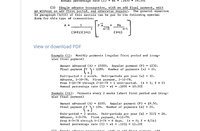Hello,
For regular APR calculation, I use Newton's method and the partial derivative of that function.
However, I now need to be able to calculate APR for biweekly payments, but I don't know what function to use or how to get the APR.
Examples below using the payment calculator from the Treasury Web site (no source code there).
Example 1:
Loan $2,995
Interest 14.99
Payment 125
Number of payments 26
Unit 14 days
1st Payment made 1 unit and 7 days out
Last payment made 26 units and 7 days out 88.97
Calculated APR = 13.4076%
-------------------------------------
Example 2:
Loan $3,463.22
Interest 26%
Payments 125
Number of Payments 33
Unit 14 days
1st Payment in a series of 32, starts 1 Unit out $125
33rd payment due 33 units out: $21.22
Calculated APR = 24.1021%
----
This APR calculation would be part of a web service called from a third party application so I need to code the algorithm (that is, the calculation can't be from a "calculator").
Can anyone help me with the formula and approach?
Thanks very much in advance,
For regular APR calculation, I use Newton's method and the partial derivative of that function.
However, I now need to be able to calculate APR for biweekly payments, but I don't know what function to use or how to get the APR.
Examples below using the payment calculator from the Treasury Web site (no source code there).
Example 1:
Loan $2,995
Interest 14.99
Payment 125
Number of payments 26
Unit 14 days
1st Payment made 1 unit and 7 days out
Last payment made 26 units and 7 days out 88.97
Calculated APR = 13.4076%
-------------------------------------
Example 2:
Loan $3,463.22
Interest 26%
Payments 125
Number of Payments 33
Unit 14 days
1st Payment in a series of 32, starts 1 Unit out $125
33rd payment due 33 units out: $21.22
Calculated APR = 24.1021%
----
This APR calculation would be part of a web service called from a third party application so I need to code the algorithm (that is, the calculation can't be from a "calculator").
Can anyone help me with the formula and approach?
Thanks very much in advance,




